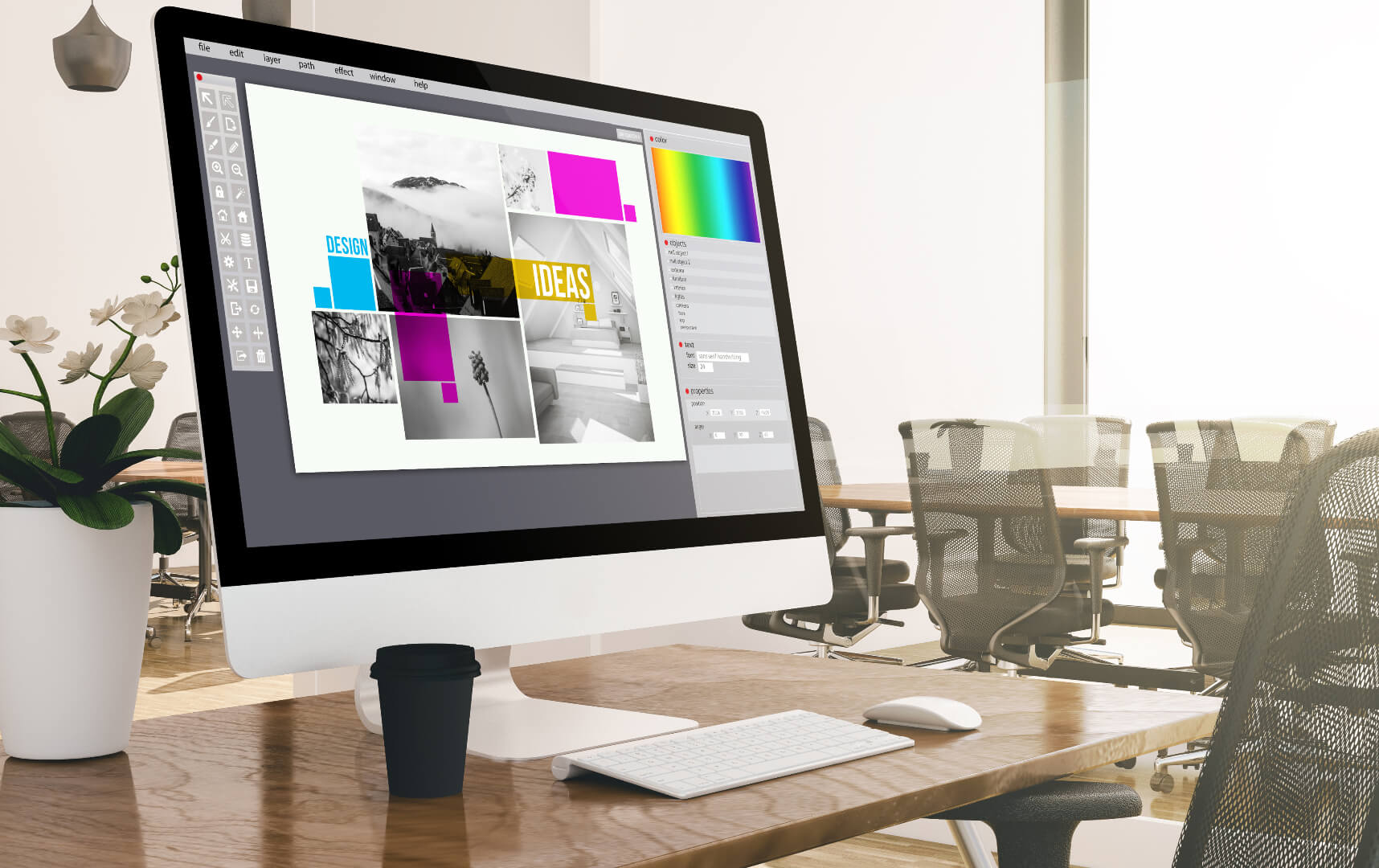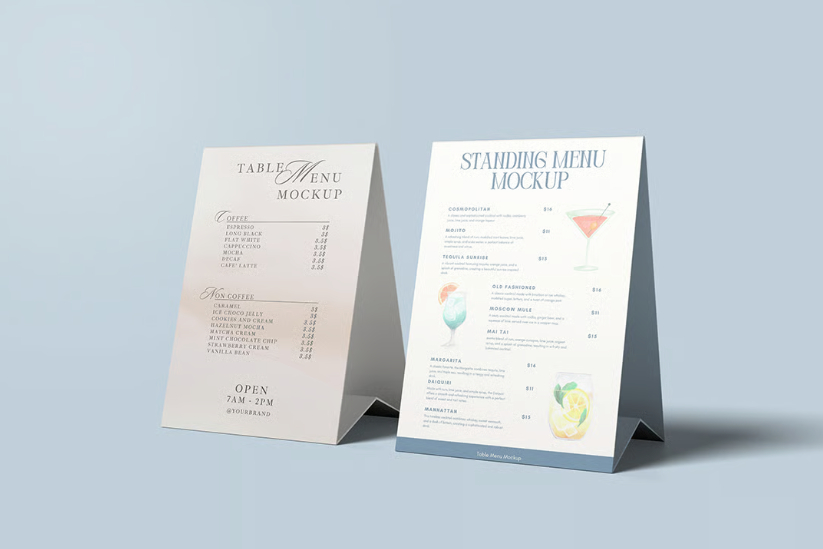Rack cards are promotional tools used in places like hotels and tourist centers to draw attention to events and services. This guide will teach you best practices for designing effective rack cards, from layout and imagery to calls to action.
What are Rack Cards?
Rack cards are promotional tools primarily used in display racks to attract nearby foot traffic. Imagine them as a blend of a business card and a brochure with a tall and slim design. You've probably seen them in places like hotels, travel centers, rest stops, store countertops, and reception desks.
These eye-catching cards offer promotional deals, event details, or contact information that you might grab while waiting in line or passing by. Their strategic placement in high-traffic areas catches your attention and provides easy access to information you might need on the go.
A rack card is a blend of visual appeal and concise communication, making it a powerful marketing tool.

Designing Eye-Catching Rack Cards
Aim for a modern, friendly look to connect with your audience when designing rack cards. This approach includes a lot of useful information in a small space while incorporating eye-catching visuals. This balanced mix of text and images leads to a successful outcome.
Design Tip: Always include your brand's colors to strengthen brand recognition.
Front Design Focus
Think of your rack card as a first impression. The fonts you use greatly influence how people perceive your brand. Make sure they're memorable and help you connect with your audience. Incorporating vibrant colors and graphics enhances visibility. Bold visuals and prominent titles play a crucial role in the front design of rack cards.
Let's face it: we're all attracted to striking images! When someone picks up your rack card, they'll first notice the images. Using high-quality photos that are sharp and clear will make a big difference. Not only will it look more professional, but it'll also make your rack card more interesting to look at. You want people to stop and actually take a look. That's how you stand out and get noticed!
Utilizing Both Sides
The front design should be simple and eye-catching to attract attention to the rack card instantly. The backside of a rack card can include more detailed information, such as important event details, contact information, a map, a coupon, etc.
Using both sides of your rack card is a smart move! It gives you more room to share important information, like your business hours, menu items, and catering options. This helps you tell a clearer story and make sure your customers have all the details they need.
Compelling Call-to-Action
Your goal is to get customers to take action after seeing your rack card. A clear call to action, like 'Visit us today!' or 'Call now for a free quote,' helps you achieve that goal.
The call-to-action text can include phrases like ‘Visit our website for more information!’ or ‘Call now to book your appointment!’. This directive approach lets your audience know exactly what action to take, increasing engagement and conversions.
Enhancing Rack Card Effectiveness
Incorporating high-quality images is vital for capturing the audience's attention. Including QR codes in call-to-actions enhances customer engagement and drives conversions.
Let’s break down some specific strategies to enhance the effective rack cards.
Adding QR Codes
Including QR codes on rack cards encourages users to interact with digital content, such as maps, menus, and special offers. QR codes can link directly to websites, promotional offers, or informational guides, streamlining user interaction with the content.
This blend of digital and print marketing guarantees your audience has easy access to extra resources and information, enriching their overall experience.
Using Professional Photography
Often overlooked, adding high-quality images can significantly enhance the appeal and professionalism of rack cards. Compelling visuals create an attractive look, and properly curated imagery boosts the effectiveness of conveying messages.
This focus on high-quality visuals ensures that your rack cards stand out and resonate with your audience.
Designer Tip: Consider using original images instead of stock photos to better connect with your brand's identity.
Clear and Concise Messaging
Less is more. Keep your text concise and to the point. This will help your key messages stand out and make it easier for customers to read and understand your rack card.
Straightforward sentences on your rack card make it easier for people to understand the key information quickly. This helps your marketing message make a bigger impact.
Popular Rack Card Sizes
There are two popular sizes, typically between 3.5” x 8.5” and 4” x 9”. Both sizes offer a wide range of customization options, such as different paper types, perforation styles, and printing choices.
However, custom sizes can be created based on specific business needs. The choice between standard sizes may depend on how the card's space is utilized.
Printing and Materials
Matte paper retains some texture, resulting in a non-reflective surface that reduces glare, making it suitable for bright environments. Gloss paper, on the other hand, has a smooth, reflective surface that enhances color vibrancy and detail sharpness, making it ideal for visually appealing printed materials.
Both matte and gloss papers are available in various thicknesses, accommodating different printing needs. Clear coatings or laminates may be applied to improve the card’s appearance and durability.
These options ensure that your rack cards look great and stand the test of time.

Key Uses for Rack Cards
Rack cards are versatile marketing tools used in various contexts. In the tourism industry, they are prominently displayed at visitor centers, hotels, and rest stops to provide information about local attractions. They are also great for promoting special events like weddings, parties, and corporate gatherings, where eye-catching designs and essential details can significantly impact.
Businesses also use rack cards to promote services and products, often placing them at reception desks or store entrances to attract potential customers.
Tourism Industry
In the tourism industry, rack cards provide important information about local attractions and experiences that cater to tourists. By collaborating with local hotels, restaurants, and tour operators, you can broaden the distribution reach of your rack cards and effectively engage tourists.
This collaborative approach enhances visibility and strengthens community support among local businesses through shared promotion.
Special Events
Whether you’re planning a wedding, a corporate gathering, or a community party, vibrant and engaging visuals should convey the excitement and fun of the event.
Event rack cards should include the date, time, location, and details about services offered, displayed effectively on the back. Businesses hosting parties, running restaurants, or operating cafes can use rack cards to inform guests about extra services like catering or entertainment options.
Rack cards can also serve as a keepsake after an event, providing important contact details for follow-ups or future gatherings. This dual purpose makes them incredibly useful for inviting people to your event and keeping in touch with them afterward.
Showcase Products or Services
Businesses can make a big splash with rack cards at conferences or trade shows by generating leads and boosting their brand presence. For the best results, place your rack cards where people are most likely to see them. This includes high-traffic areas like registration booths, exhibitor lounges, and even hotel rooms.
These cards are perfect for highlighting your standout products or services, showcasing special deals or discounts available at the event, and sharing your contact info, such as website URLs, email addresses, social media handles, or QR codes. This makes it super easy for potential customers to connect with your business after the event and dive deeper into what you offer.
Business Promotions and Sales
Businesses use rack cards to deliver promotional messages as concise marketing materials resembling smaller brochures. Various businesses and organizations can use rack cards to promote their services effectively.
For instance, car wash businesses can strategically position rack cards at gas station checkouts to effectively showcase their car wash packages and special offers and capture the attention of potential customers.
When using rack cards, consider promotional strategies that people love, like offering percentage discounts, Buy One, Get One Free deal, or even a free item with a purchase. You could also offer free delivery to sweeten the deal. These simple yet effective tactics can really boost sales and engage customers, making rack cards an important marketing tool.
Final Thought
You've got everything you need to create rack cards that really wow! These marketing powerhouses can become amazing brand ambassadors by focusing on clear messages and stunning visuals and placing them in the right places.
Always keep your ideal customer in mind. Use top-notch materials; don't be afraid to experiment with different looks to see what grabs your attention. With some creativity and these tips, your rack cards will become a valuable part of your marketing toolkit, helping you connect with new customers and achieve your business goals.




